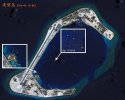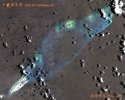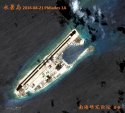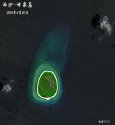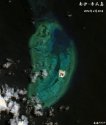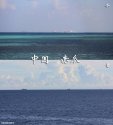By Guo Yuandan in Sansha
Source:Global Times | Published: 2016-4-19 19:50:50
Four years after China established the city of Sansha in the South China Sea's Xisha archipelago, the Global Times reporter landed on Yongxing, the main island. With its untapped tropical resources, the military presence and civilian facilities in China's southernmost city have improved quickly.
Yongxing Island, the largest in the Xisha archipelago, is more than 180 nautical miles from Sanya, South China's Hainan Province. The island serves as the seat of the Sansha city government, which was established in 2012 under the administration of Hainan.
Last Monday evening, a Global Times reporter boarded a ship and set off from Sanya. After 12 hours of high-speed sailing, they arrived on Yongxing the next morning. Right now, only people invited by the government or military can travel to Yongxing.
From the pier, one can see a set of black wooden pegs, where ships can be docked. A few tall coconut trees form a natural protective screen. Some houses sit behind the trees, one of which has a sign hung from its roof, emblazoned with military slogans.
There are also a few pavilions on the pier. Everybody on the island is welcome to rest there without going through checks or carrying ID.
The military camps are also open. There are only guards in front of important departments and all the other facilities are open to the public. Island dwellers can enjoy the medical resources of the military hospital, or see the famous "general forest," which consists of coconut trees planted by the national leaders and generals who have visited the island over the years.
Besides the pier, another facility that's been in the spotlight is the airport. The airport is still under construction, but it's not as strictly guarded as one might think. It's clear the airport is designed for both military and civil purposes.
The convergence can also be seen in its design - because the island lacks fresh water, in order to collect rain water, the runway and aircraft parking space are designed to have a slight slope. After rainwater is collected, the military purifies it and provides it to the residents.
Residents of Yongxing consist of government staff, military troops, policemen, fishermen and construction workers, with tourists dropping by now and then. The island has everything, a government, a commercial bank, a post office, a school, a residential committee, WiFi and even stray dogs. The restaurants have red lanterns hanging by their doors and hammocks stretch between coconut trees.
However, because the small island is far away from the mainland, most daily necessities need to be transported there and can be expensive.
The only school on the island, Yongxing School, proves how small Sansha is. It's the southernmost school in China and was established in 2015. The school has a kindergarten, first grade and third grade classes and 27 students, all of whom are fishermen's children. Li Ruyin is 8 years old and told the Global Times her father owns a barbecue shop and her mother cleans the streets.
Protecting the right
According to the People's Liberation Army (PLA) Daily, the ratio of soldiers to civilians is three to one on the Yongxing Island.
Zhang Yao, 24, has been serving on the island ever since he joined the army when he was 17. Standing at a boundary marker with a rifle in hand, Zhang told the Global Times that the road the reporters were walking across used to be a small dirt road, but now it has been transformed into a wide seawall highway, which is nearly 1 kilometer long and about 5 meters wide.
The tremendous improvement was achieved through the efforts made by Chinese naval officials and soldiers. In December 2015, PLA Navy Commander Wu Shengli summed "the spirit of Xisha and Nansha islands as well as the spirit of nuclear submarines" as the Chinese navy's spirit, which is to "listen to the Party's command and be loyal to the Party; be able to win the battle and fight the hard battle; maintain strict discipline and serve the people; love the ship, the islands and the sea."
As the Xisha Islands lack fresh water, there is a "rainwater squad" which consists of soldiers who are responsible for collecting rainwater, purifying it and then sharing fresh water. Back in 1999, a rainwater purifying reservoir was built in the region. Since then, the soldiers have purified more than 1.2 million tons of rainwater, which is equal to 66.67 million 18 liter barrels of water.
There is another well-known squad called the "Lei Feng squad," named after a Chinese role model for selflessness. They help civilians on the islands repair their household appliances, cars and machinery as well as aid them if they are in danger when fishing.
For tourists, the scenery on the islands is splendid. But for people actually living there, they have to face high temperatures, high humidity, high salinity and water shortages. In the summer months, the male soldiers don't wear their white summer uniforms. A soldier explained that this is because the white clothes stain easily and they don't have enough water to wash them.
Liu Tang, a commander of a naval garrison on the Xisha Islands said that during their daily training, the armed forces carry out air defense maneuvers, practice repelling landings and perform other military drills.
"Recently, because the US frequently played little tricks in the South China Sea, the soldiers' initiative and consciousness of training become even stronger. They want to train. While the intensity and the difficulty level of training is higher, they complain less," Liu told the Global Times.
Despite their devotion to training, China has paid great attention to protecting the ecosystem on the islands.
Wang Xianzhong, an engineer with Yongxing's navy, told the Global Times that the solders have grown trees and other vegetation.
When the country and the Party's leaders and the military generals visit the islands, they plant a coconut tree. Now there are more than 1,400 coconut trees. Catching turtles and picking coral is forbidden. Some household garbage is transported to the mainland for disposal. There is also a sewage disposal system on the island.
Aside from making contribution to island construction, officials and soldiers also have a good command of international law. Staff officer Jin Lei is familiar with the clauses of the United Nations Convention on the Law of the Sea, which he said is the law most frequently used by the Chinese navy in the South China Sea.
Jin said that the US has a long history of using international law. Although China started late, now it can "use the law for our purposes."
He recalls that in the past, they only took photographs of foreign ships which were hard to use as evidence. "Now when we find the other side's vessels, we will use the navigation system installed on our vessel to report our location and the other side's and then record the whole situation and each other's heading course in video. Then it will be easier to judge who violated the international law," Jin said.
For those foreign ships which illegally fish in China's waters, Jin said "we will report them to coast guard, maritime department and let the public service ships deal with them."
(continued on next post, due to 10,000 characters limitation)





